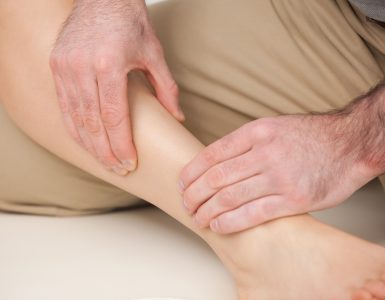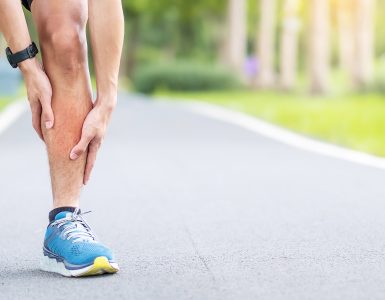You don’t necessarily have to play tennis to get tennis elbow! Tennis elbow, or lateral epicondylitis, is an inflammation or micro-tearing of the tendons that attach the muscle in the forearm to the bone in the upper arm at the elbow.
What causes tennis elbow?
Tennis elbow is usually caused by damage to the extensor carpi radialis brevis (ECRB) muscle in the forearm. The ECRB muscle helps to stabilise the wrist when the elbow is straight. When it is weakened by overuse, tiny tears can form in the tendon where it attaches to the bony knob on the outside of the elbow, causing inflammation and pain.
Although almost half of tennis players will suffer from tennis elbow at some point, especially if using incorrect techniques, it often occurs in people with occupations or activities that require the use of repetitive movements, especially the twisting and flexing of the wrist. Some examples would be people with occupations such as carpenters, plumbers, painters, butchers, computer-based workers and chefs or who participate in activities such as gardening, other racquet sports, swimming, fencing and weight-lifting.
What are the symptoms?
The symptoms of tennis elbow usually develop gradually, starting off as mild but slowly worsening over time. You may notice:
- Elbow pain that is mild at first, but gradually develops into a severe, burning pain
- Pain that extends from the outside of the elbow down to the forearm and wrist
- Weakening of your grip strength
- Swelling, stiffness and/or pain on the outside of your elbow to touch
- Increase in pain when you shake hands, squeeze an object or open a door
- Pain when lifting something, opening a jar or using tools
- Pain over the outside of your elbow after sleeping on your side.
How is it diagnosed?
Your doctor will consider various factors when making a diagnosis. An examination will be done and you will be put through some movement and touch tests to determine when and where you are experiencing pain. These tests should help your doctor to make a diagnosis. You will also be asked about how the symptoms developed, what your occupation is and if you participate in recreational sport to help in pinpointing any possible causes.
Your doctor may recommend further tests to rule out any other causes. An x-ray will help to exclude the possibility of arthritis being the cause of your pain. An MRI scan provides images of the soft tissue, including muscles and tendons, and your doctor may wish to determine the extent of the damage to the tendon. To rule out the possibility that your pain is caused by a neck problem, an MRI of your neck may be ordered.
How is tennis elbow treated?
If managed well, tennis elbow will usually heal on its own. Some types of treatment are:
- Rest. An important first step to recovery is to give your arm a rest for several weeks. It will mean taking a break from the activities that cause your painful symptoms
- Ice. Ice packs placed over the elbow will help to reduce any swelling and relieve pain.
- Medications. Taking non-steroidal anti-inflammatory medications such as ibuprofen and aspirin could help to reduce pain and swelling.
- Steroid Injections. In order to temporarily relieve pain and swelling, your doctor may decide to inject corticosteroid medication directly into the affected muscle or where the tendon attaches to the bone at the elbow.
- Brace. A common method for treating tennis elbow, a brace is centred over the back of your forearm and helps to reduce symptoms by resting the muscles and tendons.
- Physiotherapy. Using various treatments and exercises, your physiotherapist will put together a plan to help relieve your pain, strengthen the muscles in your forearms and promote healing.
- Platelet-rich plasma. Prepared from your own blood to obtain platelets, it is injected into the affected area to encourage healing.
- Extracorporeal shock wave therapy. ESWT delivers sound waves to the elbow. These sound waves cause “microtrauma” that promotes the body’s natural healing processes.
How can physiotherapy help?
Your physiotherapist will put together a management plan for your treatment, which may include:
- Manual therapy to help mobilise the elbow and wrist. If required, this could be extended to your neck and upper back.
- Exercise is the most important part of a rehabilitation program. Your physiotherapist will probably start with isometric and eccentric exercise to help over time to strengthen the tendon and relieve pain. It is important persist with the daily stretching and exercise program at the pace set by your physiotherapist so that your recovery is not delayed. This program will be individually designed based on your symptoms and progress to gradually strengthen the tendon and increase its tolerance for load.
- Your physiotherapist may recommend the use of a brace, or taping to help take the load off the affected muscles and help improve functionality.
- Soft tissue massage
- Dry needling
- Assessing your posture and applying any techniques that may be required to correct any postural deficiencies.
Everyone responds differently, so your physiotherapist will monitor your progress to ensure you gain the maximum benefit from your treatment program.
Will I need surgery?
While 80-95% of cases of tennis elbow can be successfully treated without surgery, if your symptoms have not improved after 12 months of treatment it may be necessary for you to undertake surgery to improve your condition. This surgery will involve removing the diseased muscle and then reattaching healthy muscle back onto the bone. There are two options, both of which are performed as an outpatient procedure. Arthroscopic surgery is performed through a small scope inserted into the elbow using small incisions and miniature instruments. Open surgery involves the use of a larger incision directly over the elbow. Surgery has an 85-90% success rate.
How long until I recover?
Tennis elbow can take 6 to 12 weeks to completely heal. However, if diagnosis and treatment is delayed, recovery may take much longer. Obviously, you will be keen to get back to your regular activities, but the length of time it will take will depend on your individual case and the extent of the damage to your tendon. People heal at different rates. It is important that you don’t push your recovery for starting back too early can make the damage worse.
A successful recovery from tennis elbow is highly achievable, but is largely dependent on you participating fully in the rehabilitation process.



